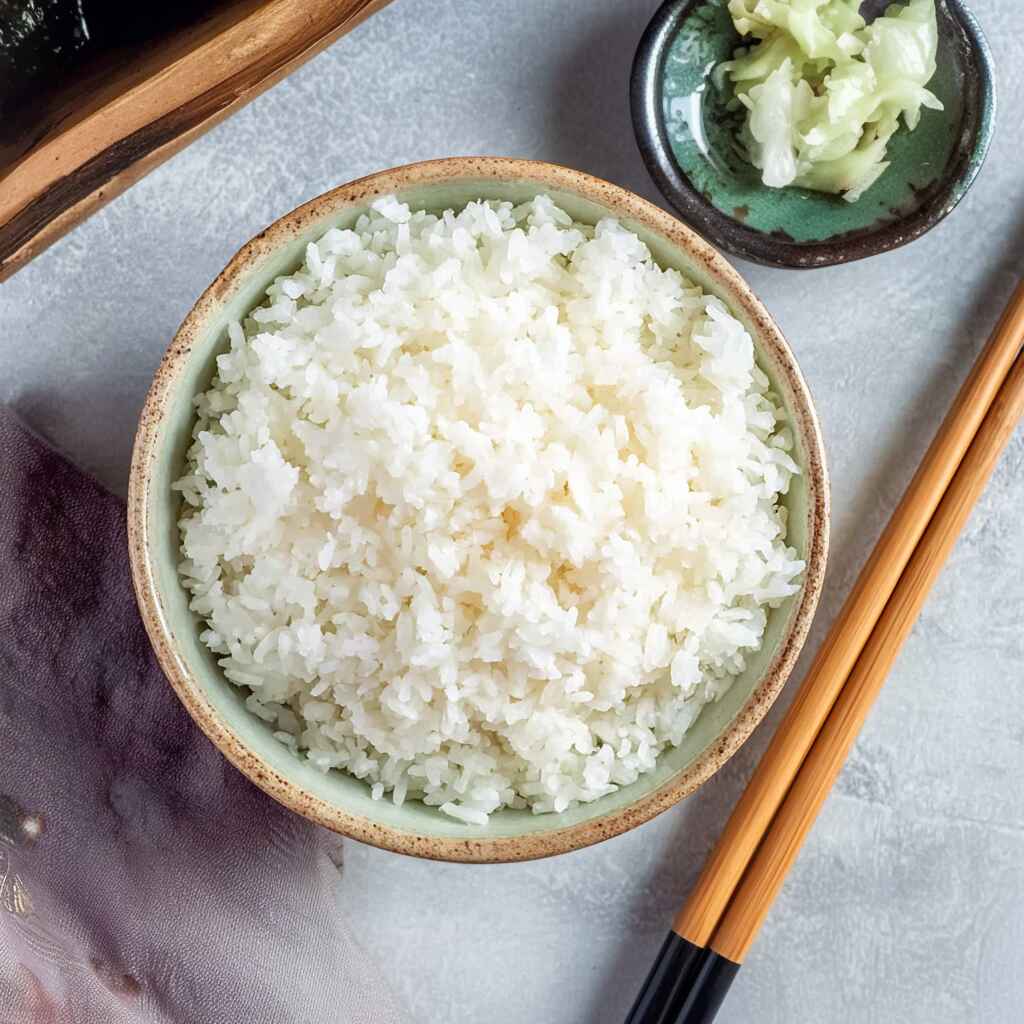There’s nothing more frustrating than trying to recreate your favorite sushi rolls at home only to find the rice isn’t quite right. Too mushy. Too dry. Too bland. If you’ve ever stood over your stove, frustrated and second-guessing your rice-to-water ratio, you’re not alone. Sushi rice might seem simple, but it’s a beautiful balancing act of texture, taste, and tradition. The good news? You don’t need a bamboo mat or a Japanese grandmother to get it right. You just need the right rice, the right method, and a little heart. This guide is your shortcut to making authentic, tender sushi rice every single time.
The First Time I Ruined Sushi Night (and Learned the Hard Way)
I remember the night I tried making sushi for my husband’s birthday. I had everything ready sliced avocado, imitation crab, nori sheets, even a bamboo roller I had no idea how to use. But I completely overlooked the rice. I just cooked “regular white rice,” fluffed it a little, and thought that would do. It didn’t.
We sat down, tried rolling the first maki, and the rice stuck to our fingers, the seaweed tore, and the flavor? Bland as plain porridge. My husband smiled kindly, but I saw the disappointment. That night, I learned: sushi rice isn’t just rice it’s the foundation of the dish.
For those who don’t know me, I’m Jacqueline Indian-American food writer, home cook, and flavor fanatic. I grew up in a home where food was celebration, and rice was treated with reverence. But it wasn’t until I ruined that sushi night that I truly appreciated the care behind Japanese rice. I’ve spent years since then testing every ratio, every brand, every steaming method until I could teach it in my sleep.
If you’ve ever made the same mistake don’t worry. This guide will walk you through what sushi rice really is, how to nail the texture, and why your rice might not be behaving. And here’s a quick tip from my kitchen: always rinse until the water runs clear it makes all the difference.
Why This Sushi Rice Recipe Just Works
Once you get the rice right, sushi becomes… calming. Almost meditative. What makes this recipe stand out isn’t just how it tastes it’s how it feels. Sticky enough to hold shape, tender enough to melt on your tongue, and seasoned in a way that doesn’t shout but whispers flavor.
The method I’m sharing was built through trial and error my own, and generations before me. I fine-tuned it after tasting sushi rice in Tokyo, and again in a tiny New Jersey kitchen where a friend’s grandmother taught me the secret: balance over boldness. It’s not about overpowering vinegar or trying too hard. It’s about rice that hums with quiet perfection.I’ve tested every ratio, every shortcut and I promise, this method won’t let you down. Whether you’re crafting maki rolls or serving a poke bowl, the rice sets the tone for everything that follows. And no, you don’t need a fancy rice cooker. A simple pot, a wooden spoon, and a little patience will do.
For anyone who’s wrestled with overcooked grains or underwhelming flavor, this recipe will feel like coming home. It also pairs beautifully with non-sushi meals like this ground beef and rice skillet when you want comfort food that still respects the grain, or this light rice pilaf for something more herbaceous.
Sushi rice isn’t a side. It’s a statement. And once you master it, you’ll find yourself making it on quiet Sundays, not just for sushi but because perfect rice feels like a small act of care.
Ingredients, Substitutions & Foolproof Steps
Sushi rice is simple, but it’s precise. You only need a handful of ingredients but how you treat them matters.
Here’s everything you need, plus some smart substitutions and pro tips so you never end up with sticky clumps or dry disappointment.
Ingredients You’ll Need:
- 2 cups Japanese short-grain white rice (like Kokuho Rose or Nishiki)
- 2 cups water (filtered, if possible)
- ¼ cup rice vinegar
- 2 tablespoons sugar
- 1½ teaspoons salt
- 1 strip of kombu (optional, for umami depth)
Ingredient Substitutions Table:
| Ingredient | Substitute | Notes |
|---|---|---|
| Short-grain rice | Calrose rice | Stickier than long-grain, still works |
| Rice vinegar | Seasoned rice vinegar | Reduce sugar and salt if using |
| Sugar | Honey | Adds slight floral note |
| Salt | Sea salt or kosher salt | Avoid iodized salt |
| Kombu | Dried shiitake or omit | Kombu adds subtle savory depth |
Common Mistakes to Avoid:
- Skipping the rinse: Starch left on rice will make it gluey.
- Overcooking: Use a timer and turn off heat as soon as water is absorbed.
- Mixing cold: Always season the rice while it’s hot it absorbs better.
Pro Tips:
- Rinse the rice until water runs clear it usually takes 4–5 washes.
- After cooking, let rice steam off-heat for 10 minutes.
- Use a wooden spoon or rice paddle to fold (not stir) the seasoning in.
- Fan the rice gently to cool it this gives it that signature glossy sheen.
Foolproof Step-by-Step Instructions:
- Rinse 2 cups of rice in a large bowl until the water runs clear.
- Soak the rinsed rice in fresh water for 30 minutes. Drain.
- Cook the rice with 2 cups of water in a covered pot over medium heat. Once it boils, reduce to low and cook for 15 minutes. Turn off heat and let steam for 10 more minutes.
- Heat the seasoning: Mix vinegar, sugar, and salt in a saucepan over low heat until dissolved. Don’t boil.
- Transfer rice to a large wooden or glass bowl (never metal).
- Pour seasoning evenly over hot rice. Use a wooden spoon to gently fold (cut and turn motion).
- Fan the rice as you mix to cool it down and lock in shine.
- Cover with a damp towel until ready to use.
Nutrition Highlights:
| Nutrient | Per Serving |
|---|---|
| Protein | 7g |
| Carbs | 12g |
| Fat | 0.5g |
This sushi rice recipe yields enough for 4 rolls or 3 poke bowls and it pairs beautifully with grilled fish, tofu, or even leftovers from one pot chicken and rice for a fusion twist.
Serving, Storage & Freezer Tips for Sushi Rice
How to Serve Sushi Rice
The beauty of sushi rice is how adaptable it is. Serve it in:
- Classic maki or nigiri sushi
- Poke bowls with marinated tofu or seared salmon
- Tucked into onigiri (rice balls) with a salty ume plum or spicy tuna center
- As a base for deconstructed sushi platters—especially if rolling feels too fussy
When plating, use slightly damp hands or a rice paddle to shape it. Never press hard; sushi rice should hold its shape, not be packed like clay.
Want something sweet for after sushi night? Pair with these bento cakes a fun, Japanese-inspired treat for all ages.
How to Store Sushi Rice
Sushi rice is best enjoyed freshly made, but if you have leftovers, here’s how to keep it soft and safe:
- Fridge: Store in an airtight container covered with a damp paper towel for up to 2 days. The rice will harden, but you can revive it.
- Reheating: Add a splash of water and cover with a damp towel; microwave in short bursts. It won’t be perfect for sushi, but works beautifully in bowls.
If you need a quick next-day breakfast? Toss in some eggs and veggies for a quick hash inspired by these breakfast sides for busy mornings.
Can You Freeze Sushi Rice?
Yes but only in a pinch. While it won’t have the delicate texture of fresh sushi rice, it can still be reused in bowls or wraps:
- Cool rice completely, then pack tightly into freezer-safe bags
- Label and freeze for up to 1 month
- Reheat with a sprinkle of water, covered, until soft again
Avoid using thawed rice for traditional sushi rolls. The texture shift is noticeable.
From My Kitchen to Yours
When I make sushi rice now, I don’t just think of getting it right. I think of that first night I got it wrong and how much love went into trying. Cooking is like that. You mess up, you learn, and eventually… you teach someone else.
If this recipe makes your dinner table feel more connected, or brings joy to someone you love, that’s the real win.
Frequently Asked Questions About Sushi Rice
1. What kind of rice is sushi rice?
Sushi rice is made from short-grain Japanese rice, known for its stickiness and tender texture. Look for varieties like Koshihikari, Nishiki, or Kokuho Rose. These grains are slightly plump, round, and designed to cling together perfect for rolling or molding.
Unlike long-grain rice, which separates when cooked, sushi rice becomes pleasantly chewy and holds its shape, making it essential for everything from maki to onigiri.
2. Can I turn normal rice into sushi rice?
You can try, but results will vary. Short-grain or medium-grain rice can be seasoned with vinegar, sugar, and salt to mimic sushi rice flavor but long-grain or basmati won’t provide the stickiness or texture needed for rolls.
If you’re in a pinch, Calrose rice is a decent substitute. But for best results, use authentic sushi rice it’s worth the small effort.
3. What’s the difference between sushi rice and regular rice?
The key difference lies in grain type and seasoning. Sushi rice uses short-grain Japanese varieties that turn sticky when cooked, then it’s seasoned with a precise balance of rice vinegar, sugar, and salt.
Regular white rice is typically long-grain and left unseasoned. It’s fluffy and dry, making it perfect for dishes like pilaf, but not suitable for sushi where the rice needs to cling.
4. What is sushi rice called at the grocery store?
Look for labels like “Sushi Rice,” “Calrose,” “Japanese Short Grain Rice,” or specific brand names like Nishiki and Kokuho Rose. You’ll usually find it in the Asian foods aisle or with other specialty rices.
Avoid anything labeled “long grain,” “jasmine,” or “basmati” for sushi purposes they just won’t work the same way.
Conclusion: Let Rice Tell the Story
Sushi rice is more than a side it’s a story told in grains. It carries the weight of care, culture, and quiet precision. Getting it just right brings a deep, surprising satisfaction, and once you’ve made it well, you’ll crave it often.
If this recipe reminds you of someone you love, share it with them. Your memories keep recipes alive.
Recipe written by Jacqueline – from our kitchen to yours.
You May Also Like
Sushi Rice
Ingredients
Equipment
Method
- Rinse the rice in a large bowl under cool water until the water runs clear.
- Soak the rinsed rice in fresh water for 30 minutes, then drain.
- Add the rice and 2 cups of water to a pot. Bring to a boil, then cover and reduce to low. Cook for 15 minutes, then turn off heat and let steam for 10 minutes.
- While the rice steams, gently warm vinegar, sugar, and salt in a saucepan until dissolved. Do not boil.
- Transfer hot rice to a wooden or glass bowl. Pour vinegar mixture evenly and fold with a rice paddle using cutting motions.
- Fan the rice while mixing to cool and add sheen. Cover with a damp towel until ready to use.

